In this article, we will share the best SEO blog tips to help you optimize your blog posts best for SEO. These are the tips that we use on our own blog, attracting millions of visitors from search engines.

1. Plan your content and research appropriate keywords
Many beginners will often write content based on their predictions to write on topics they feel that their users will be interested in.
You don't need to rely on blind guesses, especially when you can do keyword research to find out exactly what your users are looking for.
Keyword research is a technique used by content creators and SEO experts. It helps you discover topics that your users are interested in based on search engine data.
You can then use these keywords to plan your content strategy. This will ensure that you write about the topics that people are really looking for, and it's a great way to find new blog post ideas.
We recommend using keyword research tools like SEMRush or Ahrefs. They provide in-depth keyword data, competitive analysis, keyword location tracking and tons of other useful features.
If you are using SEMRush, then you will want to check out their SEO Writing Assistant tool. It helps you discover LSI and related keywords, readability, tone and average article length.
2. Find semantic keywords for your focused keywords
After you've done keyword research and discovered keyword ideas, it's time to choose an idea that has the highest search volume and low competition.
This will be your focus keyword. It is the search term that your users are most likely to search.
If you are using the plugin Yoast SEO, then you can put the focus keyword in the section Focus Keyword. This will allow you to see how effectively you have used it in your article.

Next, you need to find the Latent Semantic Indexing (LSI) keywords. These are searches related to your focus keywords.
The easiest way to find them is to simply enter your focus keyword into Google Search and scroll down to the bottom of the results page. There, you will see them listed as related searches.
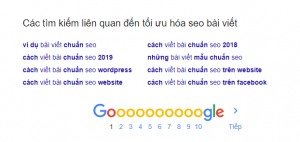
You need to combine many keywords in your content to get the most complete content for users.
3. Post title
The title of your blog post is extremely important for search rankings.
A good blog post title makes your post more relevant to the search query. More importantly, it motivates users to actually click on your article when they see it in search results.
You can make your blog post title more SEO friendly by using your keyword focus in the title.
In addition to adding your focus keywords, we also recommend making your title more attractive.
There are several formulas for writing effective titles. One of them is called EMV or emotional marketing value.
This formula recommends using words that trigger specific emotional responses in your audience.
4. Create internal links
Once you've been blogging for a while, you'll have enough content that you want users to read. With internal links, you can help readers check out relevant older posts.
Internal linking is a great way to develop a contextual relationship between your new and old posts.
WordPress makes it easy to find your old posts right in the post editor. Just select the text you want to link and then click the link button.

Creating internal links will ensure that the SEO on your site is good and your old posts keep getting new links.
Often beginners make the mistake of making a one-way internal link where they link to older posts from new posts. You should also go back to editing older posts to link to your new posts for maximum benefit.
5. Add images and videos to your blog post
Search engines often rank higher content in search results. Images and videos are much more attractive than plain text.
You want to make sure that your blog posts contain images between paragraphs.
When adding images, you should be careful about image copyright. Typically beginners copy images from other websites for use on their site and this can put you in legal trouble if you do so without proper permissions.
Don't worry, there are many places where you can find royalty-free images to use in your blog posts. You can also use photos created by yourself.
Make sure you optimize your images for SEO. See our guide on how to optimize images for search engines for detailed instructions.
Videos are even more engaging than images. You can convert your blog post into video by creating slideshows, vlogs or experimenting with other formats.
However, you should never directly upload videos to your blog posts. WordPress is not optimized to serve your videos and shared hosting services can handle them.
We recommend uploading your video to YouTube. It is the second most popular search engine and the second largest social media platform right after Facebook.
6. Add a Description to your Blog Post
Description is an HTML meta tag that you can add to any page. Its purpose is to provide a short description of your article to search engines and other crawlers.
A good description can explain more about an article. Social media sites like Facebook, Twitter and LinkedIn also show it when your posts are shared on those platforms.
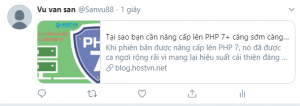
Because now that you know that people will read your meta descriptions, you want to make sure it helps.
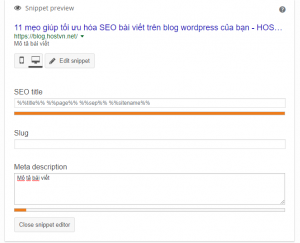
You also want to make sure that you mentioned your focus keyword at least once in the meta description for search purposes. The character limit for Meta Description is 155 characters, try to write description within that limit
You should also make sure that you use focus keywords in the article description.
7. Make your writing more readable
Readability is an important factor considered by search engines. More readable articles often rank higher than unfriendly articles.
Computer monitors and mobile phones are still not an optimal platform to read.
This is why most users only glance at posts. In fact, studies show that users spend less than a second deciding whether they want to stay on a page or leave.
It is a very short time for you to convince users to stay and scroll through. By improving the readability, you can help users can quickly decide that.
You can improve your reading by using shorter sentences, smaller paragraphs, punctuation, titles and bulleted lists. We recommend adding whitespace around the text and using images to make your text look better.
You can use tools like Grammarly, which allow you to check grammar, punctuation, and spelling on the fly. It also gives suggestions to improve the readability of your articles.
The Yoast SEO plugin also comes with an integrated readability tester. It shows the flesch reading point of your article in the Readability Analysis tab.
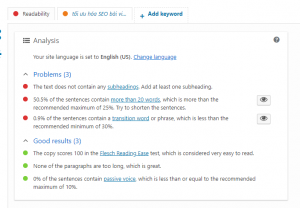
8. Use Categories and Tags to organize Content
Categories and tags help you organize content not only for yourself but also for readers and search engines.
The problem is that many WordPress beginners often end up using them improperly.
If you think of your website as a book, categories will be a table of contents and tags will be an index of the book.
The type used to divide your content into the main topics discussed on your blog. Tags, are the topics discussed in a personal blog post.
9. The goal of becoming featured snippets in search results
Google has tried to answer user questions as quickly as possible. As part of this effort, they introduced a result box or typical answer.
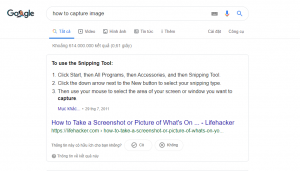
According to research conducted by Advanced Web Ranking, the Answer Security box is nearly 32.3% TLB. This makes them extremely important for your SEO strategy.
There is no specific set of guidelines provided by Google on how they will select featured snippets. Their suggestion is to improve your content and ensure that it provides the information that users are looking for.
10. Make your Blog posts comprehensive
Search engine favorite articles cover a very detailed topic. This is why we ask that you collect semantic related keywords (LSI Keywords) as part of your content planning step.
These related keywords give you an idea of the different variations of user searches related to that particular topic. By including the keywords in your article, you will be able to make it more comprehensive, more informative and useful.
You should use titles and subheadings to include those keywords and try to cover as much as possible.
In addition to LSI keywords, another tip for creating complete content is to enter the keywords you want and then switch to Image Search. You will see the theme bubble with many keywords.

We recommend that you include these when creating your content, so you can have the most comprehensive content.
11. Optimize blog posts
Many beginners tend to forget a blog post after they have published it. In fact, you haven't finished optimizing your blog post for SEO after it has been published.
Here are some things you need to do after publishing your blog post:
- Advertise it on social media - Advertise your blog post on your social media channels.
- Add internal links - Once you've published a post, you can go back to the relevant old posts and add a link to your new blog post.
- Tracking search rankings - We recommend optimizing your old posts on a regular basis, so you can continue to improve your rankings.
We hope this article helped you optimize your blog posts for SEO like a pro. Good luck.
According to wpbeginner



0 Comments